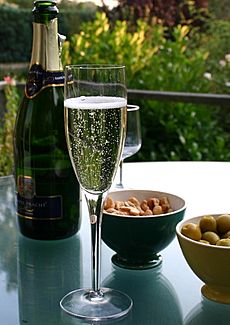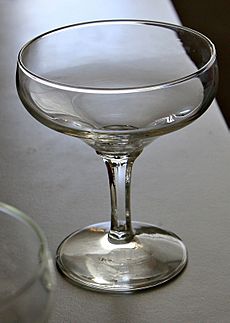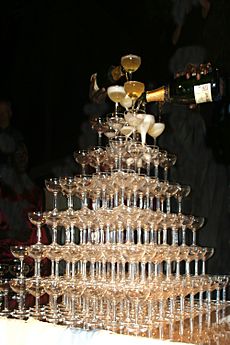Champagne glass facts for kids
A champagne glass is a special type of drinking glass. It has a stem, which is a thin stand, and is made for serving sparkling wines like champagne. The two most common shapes for these glasses are the flute and the coupe.
Holding the glass by its stem is important. It stops your hand from warming up the drink inside. This helps the drink stay cool and bubbly for longer. While you can drink sparkling wine from a regular wine glass, special champagne glasses are designed to make the bubbles and flavors stand out.
The Champagne Flute
The champagne flute is a tall, slender glass. It usually holds about 180 to 300 milliliters (about 6 to 10 fluid ounces) of liquid.
This type of glass became popular in the early 1700s. Before that, people often used cups made of metal or ceramic. As glassmaking got better, new shapes for wine glasses were created. The first flutes were very tall and straight. Over time, their shape changed slightly, curving inward a bit near the top.
This inward curve is a clever design. It helps to keep the tiny bubbles, called carbonation, from escaping too quickly. The smaller opening means less of the drink's surface is open to the air. This helps the bubbles last longer. When you see lots of bubbles rising in a flute, it looks really cool!
The narrow shape of the flute also helps with the smell and taste. It keeps the air from mixing too much with the drink. This makes the wine's aroma and flavor stronger and more enjoyable.
Even though flutes are mostly used for sparkling wines, they are also sometimes used for certain types of beer. These include fruit beers and special Belgian beers like lambics. The flute's design shows off the beer's color and helps you smell its unique scent. A champagne flute is different from a pilsner glass because the flute has a stem, but a pilsner glass does not.
The Champagne Coupe
The champagne coupe is a different style of glass. It has a wide, shallow bowl and a stem. It can hold about 180 to 240 milliliters (about 6 to 8 fluid ounces) of liquid.
The coupe was very popular in France from the 1700s until the 1970s. In the United States, it was fashionable from the 1930s to the 1980s. Today, coupes are often used for serving cocktails that are meant to be served "up" (without ice). This is because their wide bowl makes them less likely to spill than some other cocktail glasses.
The Tulip Glass
Sometimes, sparkling wine is also served in a tulip glass. This glass is wider than a champagne flute, especially at its body and mouth.
Some experts who really love wine prefer the tulip glass. They say it allows you to smell more of the wine's aroma than a traditional flute. At the same time, its opening is still narrow enough to keep the bubbles from disappearing too fast.
A food writer named Dave McIntyre once explained why he liked the tulip glass. He said it helps the sparkling wine reach the middle of your tongue, which lets you taste its full flavor better. Some glass makers, like Riedel, even say that flutes are too simple. They believe flutes stop people from truly enjoying all the different smells and tastes a sparkling wine can offer.
Double-Wall Glasses
In the 1960s, a new type of glass was invented: double-wall stemware. These glasses have two layers of glass with a small space filled with air in between. Air is not good at transferring heat. This design helps to keep the drink cold for longer by slowing down the heat from your hand.
See also
 In Spanish: Flauta de champán para niños
In Spanish: Flauta de champán para niños




